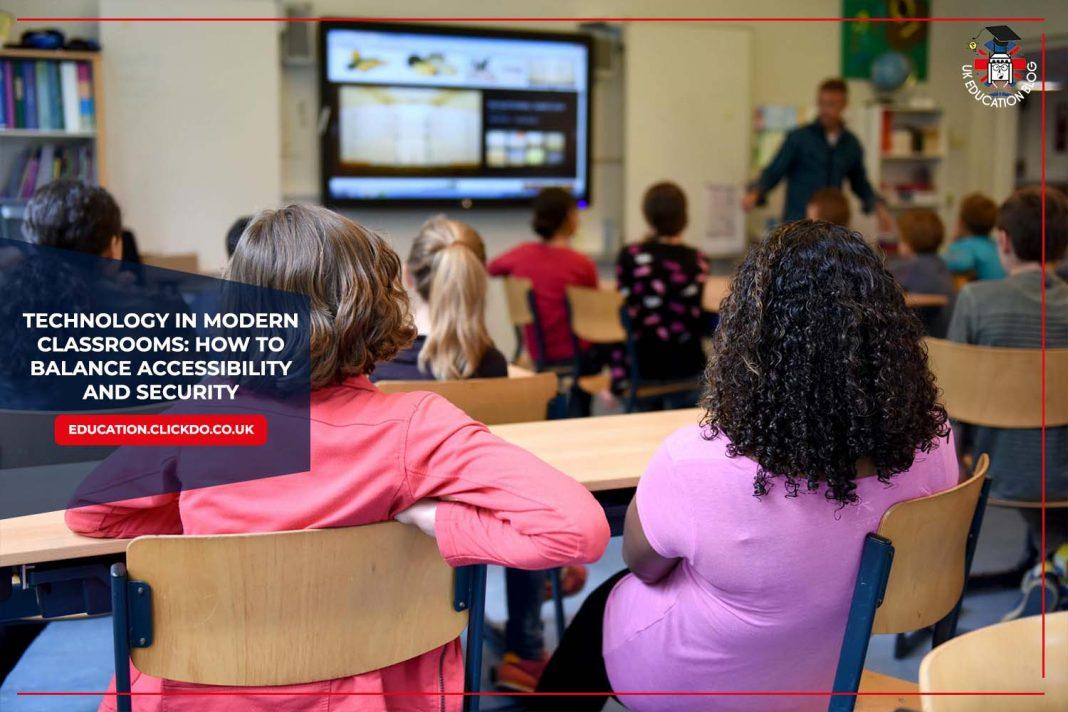In today’s quickly changing digital landscape, technology has altered how we teach and learn.
From interactive whiteboards to cloud-based learning systems, the use of digital technologies in classrooms has created new opportunities for teachers and students alike.
However, these developments build challenges in preserving security and safeguarding private information even if they make education more available.
Schools must find a balance between security and accessibility if they want to guarantee a secure and effective classroom.
The Rise of Technology in Education

Technology’s application in the classroom is now considered an essential rather than a luxury. Devices like tablets and laptops are being used by colleges and universities to support group learning, tailored education, and quick access to international resources. By allowing students to attend lectures from anywhere in the globe, tools like video conferencing software help to remove constraints of time and geography. Online hosting systems also give teachers the tools to easily produce, distribute, and control instructional materials.
But the hazards related to cybersecurity are becoming increasingly apparent as schools depend more on technology. Rising cyberattacks on educational institutions target institutional records and sensitive student data. Schools must invest in robust digital ecosystems that prioritize security while maintaining accessibility.
Managing Internet Access in Schools
Modern classrooms depend on a properly run online infrastructure. Although students should have free access to instructional materials, unmonitored browsing can expose them to dangerous content or hostile tools of attack. Having a proxy server is one smart approach to protect browsing online in classrooms.
Between users and the internet, a proxy server serves as a middleman allowing administrators to maintain a flawless browsing experience while monitoring, filtering, and limiting access to particular websites. It’s important to have a proxy server to guarantee security.
By giving critical instructional information top priority over non-academic pursuits, proxy servers also help to control bandwidth. This ensures that schools can maximize their network for educational purposes without experiencing excessive delays or interruptions. Moreover, proxy servers provide an additional degree of security shielding consumers from phishing frauds and other online hazards aimed at educational institutions.
Enhancing Security in Digital Classrooms

Schools have to take extra steps to improve cybersecurity beyond just using proxy servers. Successful strategies include frequent security audits, using SSL certificates to encrypt data, and teaching staff members and students safe browsing habits. Further guaranteeing data security is hosting instructional platforms on safe servers, including those provided by trustworthy companies like ONE.com.
These steps can help schools build a digital ecosystem that supports innovation while protecting private data. For instance, built-in security measures of domain hosting help to guard online resources from illegal access, therefore allowing teachers to concentrate on their work rather than on potential attacks.
Balancing Technology and Privacy
While security is crucial, it is also critical to protect kids’ and staff’s privacy. Schools must make sure that instruments for surveillance, such as proxy servers, are applied responsibly and transparently. Clear policies should be shared stressing the use of these instruments and their contribution to a safer online learning environment.
Furthermore, implementing user-friendly solutions helps teachers and students interact with technology without feeling overwhelmed by its complexity. Schools can help to build a culture of trust and understanding in which technology acts as a bridge to knowledge rather than a barrier.
The Future of Technology
Technology is transforming modern classrooms by providing formerly unheard-of knowledge access and growth-oriented opportunities. However, immense power entails considerable accountability. Schools must navigate the fine line between giving staff members and kids wide access to digital resources while maintaining a safe environment.
Using tools like proxy servers and safe hosting solutions will help educational institutions open the path for a time when technology and education coexist harmoniously. The classrooms of tomorrow may be both creative and safe with the correct policies in place, therefore attesting to the power of digital development.
Author Profile

- Editor in Chief
- Blogger and Educator by Passion | Senior Online Media & PR Strategist at ClickDo Ltd. | Contributor to many Education, Business & Lifestyle Blogs in the United Kingdom & Germany | Summer Course Student at the London School of Journalism and Course Instructor at the SeekaHost University.
Latest entries
 Directory PostsOctober 29, 20257 Not-To-Miss UK Education Conferences in 2026
Directory PostsOctober 29, 20257 Not-To-Miss UK Education Conferences in 2026 Directory PostsOctober 16, 2025The 12 Best Online Tutoring Platforms in the UK
Directory PostsOctober 16, 2025The 12 Best Online Tutoring Platforms in the UK Directory PostsOctober 6, 2025Top 12 London Private Schools – Best Independent Schools Nearby
Directory PostsOctober 6, 2025Top 12 London Private Schools – Best Independent Schools Nearby careerSeptember 10, 20258 Top Online Future Career Courses To Know
careerSeptember 10, 20258 Top Online Future Career Courses To Know







